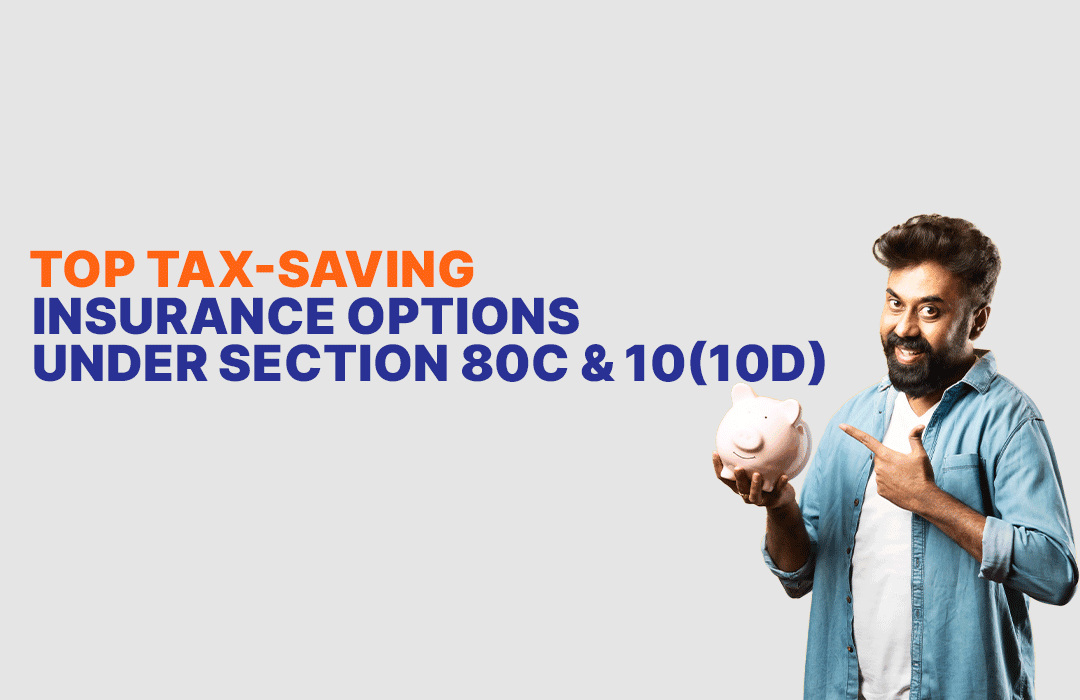Insurance and taxation are frequently associated in Indian financial planning. On one hand, insurance provides a safety net for the family. Also, significant tax breaks can also be expected under the Income Tax Act.
Insurance not only protects your family’s future but also entitles you to significant tax breaks under the Income Tax Act. Sections 80C and 10(10D) are two of the most relevant provisions in this context.
If you are looking for ways to save on tax, then understanding how these sections work as well as which types of insurance plans allow you to avail maximum benefit and can give you a breathing space. Additionally, insurance also offers long-term financial security.
Understanding how these sections work and which types of insurance plans allow you to save taxes while assuring long-term financial security. Let's look at the best insurance solutions for maximising your savings under these rules.
A Quick Overview of Section 80C and Section 10(10D)
Section 80C: Deduction for Premiums Paid
It entitles you to a deduction of up to ₹1.5 lakh per year for life insurance premiums.
Both individuals and HUF taxpayers are eligible.
Premiums cannot exceed 10% of the sum guaranteed (for policies issued after April 1, 2012).
Section 10(10D): Exemption for Maturity Proceeds
Any amount received as maturity or death benefits is completely tax-free.
Exemption also applies to bonuses.
Requirements: If the premium is less than or equal to 10% of the sum insured. The proceeds may be subject to taxation if the maturity period surpasses.
Top Tax-Saving Insurance Options
1. Term Insurance Plans
Term plans are the cheapest. They are essential as they provide significant coverage at low premiums.
Under 80C: Premiums can be deducted up to ₹1.5 lakh.
Under 10(10D): The death benefit received by nominees is completely tax-free.
Why choose? A pure protection plan protects the financial security of dependents.
Example: Rohan, a 30-year-old boy opted for a ₹1 crore insurance coverage amount and pays ₹10,000 per year then he can claim the deduction of the entire premium paid by him under 80C. If the insured dies, the nominee receives the death payment assured tax-free under 10(10D).
2. Unit Linked Insurance Plans (ULIPs)
ULIP has a component of investment and insurance. Some component of the premium goes towards life insurance while the remaining amount is utilized towards investment (equity or debt).
80C: Premiums are deductible (subject to limitations).
10(10D): Returns are excluded if the annual premium is less than ₹2.5 lakh (as per new rules).
Why choose? The returns are market linked and therefore these are generally preferred by those people who want to go for market linked returns.
3. Endowment Policies
Traditional life insurance plans that combine risk cover with guaranteed savings.
80C: One can claim deduction on premium paid.
10(10D): Tax-free lump sum + bonuses (if premium ≤ 10% of sum assured).
Why choose? Low-risk, disciplined savings along with protection.
Example: Paying ₹50,000 annually towards a 20-year endowment policy qualifies under 80C, and maturity proceeds (say ₹15 lakh) are exempt under 10(10D).
4. Money-Back Policies
These policies pay survival benefits at periodic intervals along with maturity and death benefits.
80C: Claiming income tax deduction of up to ₹1.50 lakh is possible.
10(10D): Both periodic payouts and maturity are tax-free.
Why choose? Regular cash flow plus risk cover.
Example: Mohit has a money-back plan that pays him 20% of the sum assured every five years. It not only ensures liquidity but also keeps the maturity amount tax-free.
5. Guaranteed Return Plans
As the name suggests, Guaranteed Return plans offer fixed returns on maturity. They are not market linked plans.
80C: Payment of premium entitles you tax deduction.
10(10D): Proceeds are fully exempt from tax (conditions apply).
Why choose? Predictable returns, low-risk investment with life cover.
6. Pension/Retirement Plans (With Insurance Component)
Some retirement-focused life insurance policies offer annuities along with life coverage.
80C: Premiums deductible.
10(10D): Lump sum received on vesting or death benefit is exempt. (However, annuity income is taxable as per slab).
Why choose? Ideal for building a retirement corpus with insurance protection.
7. Child Insurance Plans
Designed to secure a child’s education and future needs, these policies combine savings + insurance.
80C: Premiums paid for child insurance plans qualify.
10(10D): Tax-free lump sum ensures child’s financial security.
Why choose? Goal-based savings for child’s education/marriage.
Key Points to Remember for Tax Benefits
To avail benefits, ensure premiums are not more than 10% of sum assured.
If premiums exceed limits, maturity may be taxable (except in case of death benefits).
Deduction under 80C is capped at ₹1.5 lakh annually (including PPF, ELSS, etc.).
For tax filing, ensure to keep receipts as well as documents.
Criteria to Choose the Right Tax-Saving Insurance Plan
When selecting a plan under 80C & 10(10D), consider:
Objective – Protection (Term), Savings (Endowment), Investments (ULIPs), or Retirement.
Risk Appetite – ULIPs are for risk seeking individuals, Endowment is for risk averse.
Liquidity Needs – Money-back policies for regular payouts.
Long-Term Goals – Child plans or guaranteed return plans.
Final Thoughts
In addition to proving safety, Insurance is also considered an effective tax-saving instrument in India. You can protect your family while lowering your tax liability by taking advantage of Section 80C (premium deductions) and Section 10(10D) (tax-free maturity).
A simple term plan, a growth-oriented ULIP, or a solid endowment/money-back policy are some of the insurance types available in the market but the common attribute they share is that they have a distinct combination of protection and tax savings.
If you want a financial safeguard and tax-saving tool, then you should begin early and make intelligent decisions.
Pro Tip: Although insurance helps individuals to avail tax deduction but it should not be bought only for tax purposes. It would be a better option if you consider financial objectives as well as risk tolerance.

